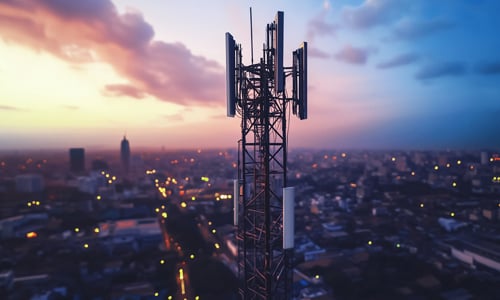Structural tension: how capturing 5G enterprise revenue challenges MNOs
Most new service revenue enabled by 5G standalone will come from enterprises and industry sectors, yet mobile network operators (MNOs) must rapidly transform their service assurance to meet the requirements of these customers. Not all are on track to do so.
A global survey of MNOs conducted by GSMA’s Mobile World Live in May, 2021 paints a dynamic picture of the structural tension involved in deploying and assuring 5G standalone networks and services in a way that meets enterprise and industry requirements.
Insights from this survey, discussed below, show the discrepancy between current capabilities and goals for 5G. Since 5G is a completely new network with service-based architecture, MNOs have no choice but to adapt. That means deciding which services to focus on first and adding the service assurance capabilities that those use cases require. MNOs that fall short of doing this will never close the gap between current reality and future goals.
Vision: capture new 5G revenue from enterprises and industry customers
Most 5G standalone revenue (70%) is expected to come from enterprise and industry customers. Demand for these services will be from a variety of sectors, including hyperscale edge-enabled applications, automotive, video distribution and analytics and manufacturing.
But 89% of enterprise and industry 5G standalone services will be subject to service level agreements (SLAs). Making good on those service guarantees requires that MNOs transform their service assurance.
Current reality: MNOs lack real-time user experience visibility needed for 5G
Less than 1-in-5 (18%) of MNOs have a clear view of user experience (QoE). Gaining that visibility is crucial.
80% of MNOs say service assurance for 5G requires real-time KPI feedback so applications can adapt to deliver optimized user experience.
Other priorities for 5G service assurance, according to MNOs, include:
- integrated service, network and telco cloud performance monitoring
- real-time correlation across events, faults, telemetry, QoS and QoE analytics
- orchestrated active testing for dynamic services like slicing
- correlated active and passive monitoring metrics
- per-user/per-device monitoring
- end-to-end network slice monitoring
- multi-access edge computing (MEC) infrastructure monitoring
Consider these key words in the requirements MNOs identified: integrated, real-time, orchestrated, correlated, per user/per device, end-to-end… most are transformative, and all are significant change drivers.
The visibility gap created by the lack of these capabilities must be closed before MNOs can scale out the orchestrated networks and 5G services required to generate and sustain new revenue streams.
The gap: incapacity to guarantee service performance threatens 5G revenue
Only 2% of MNOs think their current approach to service assurance and orchestration is sufficient for 5G. There is significantly less agreement—and some discrepancy—regarding what it means to rethink service assurance and on what timeline.
For example, 75% of MNOs say they will use a unified approach to orchestrate and assure 4G and 5G networks. This requires a common service assurance foundation. But this leaves about a quarter unsure how they will approach 4G-5G assurance and orchestration.
This is clearly a problem. SLAs will only succeed with comprehensive knowledge about all aspects of network performance. For many operators, there is work to do. That said, only around half of respondents (53%) said they are planning to monitor end-to-end performance in their new 5G standalone network. The majority will monitor most domains, albeit separately. This runs the risk of adding fresh complexity into network operations as opposed to the clarity of end-to-end performance.
Much of this is uncharted territory with complex problems to solve. Solutions and success will be incremental and evolutionary, not overnight.
The future: take a phased approach to adaptive service assurance for 5G
MNOs say that 61% of SLA-governed 5G revenue can't be delivered without real-time service assurance. They identify real-time monitoring, reporting and visualization and being able to prioritize issues by customer impact as the two most critical service assurance capabilities to sell 5G standalone services.
The path of least resistance to address the structural tensions discussed here, then, is to rapidly and efficiently enable the most critical assurance capabilities that MNOs identified. What is the least complicated way to do that, with the highest likely ROI in the shortest time?
Answer: Adaptive service assurance, which collapses analytics resources and big data overhead by 90% over traditional methods while providing crucial per-user and per-device monitoring necessary to monetize 5G standalone. It automatically measures only what’s needed, when needed—in context—to deliver real-time insight and closed-loop feedback for orchestrated 5G standalone networks.




